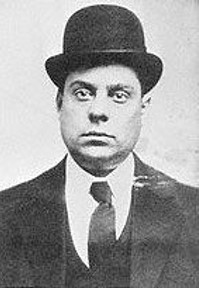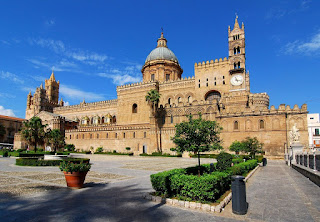NEW - Giuseppe Morello - gangster
Sicilian established first New York crime ‘family’
The Mafia boss Giuseppe Morello, who is credited with building the first of the New York gangs to be known as a crime ‘family’, was born on this day in 1867 in the notorious Sicilian crime stronghold of Corleone, a small town in a mountainous area 50km (31 miles) inland from the island’s capital, Palermo. Morello had a deformed right hand with a single finger that was always bent, on account of which he became known as Joe l’artiglio - Joe ‘the claw’. Along with three half-brothers, Morello established the 107th Street Mob in the East Harlem district of Manhattan in the late 1890s. The gang is recognised as the organisation that would eventually evolve into the Genovese crime family, the oldest of the New York Mafia’s so-called Five Families. Morello is thought to have been brought up among the criminal underworld in Sicily on account of his widowed mother, Angelina, marrying Bernardo Terranova, a prominent member of the Corleonesi Mafia. Giuseppe was only six years old at the time but when he reached maturity, he and his half-brothers, Vincenzo, Ciro and Nicolò, began to take part in Mafia activity. Read more…
________________________________________
Pietro Frua - car designer
Built business from a bombed-out factory
The car designer and coachbuilder Pietro Frua, who built some of Italy’s most beautiful cars without achieving the fame of the likes of Giovanni Bertone or Battista “Pinin” Farina, was born on this day in 1913 in Turin. He is particularly remembered for his work with Maserati, for whom he designed the A6G and the Mistral among other models. The son of a Fiat employee, Carlo Frua, Pietro was an apprentice draughtsman with Fiat and from the age of 17 worked alongside Battista Farina for his brother, Giovanni Farina, who had a coachbuilding business in Turin. He became director of styling for Stabilimenti Farina at the age of just 22. After being obliged to diversify during the war, when he designed electric ovens and children’s model cars among other things, Frua bought a bombed-out factory building in 1944, restored it to serviceable order and hired 15 workers to help him launch his own business. The first car he designed in his own studio was the soft-top Fiat 1100C sports car in 1946. Subsequent work for Peugeot and Renault came his way and in 1955 he was approached by Maserati for the first time. Read more…
______________________________________
Michele Busiri Vici - architect
Key designer in Costa Smeralda project
The architect Michele Busiri Vici, whose distinctive work featured heavily in the development of the Costa Smeralda in Sardinia as an exclusive holiday playground in the 1960s, was born on this day in 1894 in Rome. Along with the French architect Jacques Couelle and his fellow Italian, Luigi Vietti, Vici was commissioned by the Aga Khan, Prince Shah Karim al-Husseini, to develop the area at the northeastern tip of the island and build a new resort, Porto Cervo. The prince, himself said to be worth $13.3 billion as one of the world’s richest royals, assembled a consortium of investors to finance the project, which began in 1961 and remains a destination popular with celebrities, business and political leaders and other wealthy individuals. Vici’s contributions included the highly distinctive church of Stella Maris in Porto Cervo, the Hotel Romazzino and Hotel Lucia della Muntagna and numerous villas. He also left his mark on Porto Rafael, a small resort founded by another wealthy individual, Raphael Neville, Count of Berlanga de Duero, in the late 1950s. There he designed the Piazzetta, a chapel, and private villas. Read more…
_____________________________________
Alessandro Scarlatti - composer
Prolific opera composer was ahead of his time
Baroque composer Alessandro Scarlatti was born on this day in 1660 in Palermo. He is considered to be the founder of the Neapolitan School of opera, from which modern opera developed, and his two sons, Domenico and Pietro Filippo, also went on to become composers. Scarlatti is believed to have been a pupil of Giacomo Carissimi in Rome. When his opera Gli equivoci nel sembiante was produced in the city he gained the support of Queen Christina of Sweden, an enthusiastic patron of the arts who had taken up residence there. He became her maestro di cappella and joined the Arcadian Academy she had founded. Along with composers Bernardo Pasquini and Arcangelo Corelli, he regularly visited her home to perform music he had dedicated to her. In 1684 Scarlatti became maestro di cappella to the royal family in Naples and produced a series of operas and music for state occasions for them. Scarlatti also enjoyed the patronage of Ferdinando de' Medici and composed operas for his private theatre near Florence. He was also maestro di cappella for Cardinal Pietro Ottoboni who procured him a post at the Basilica di Santa Maria Maggiore in Rome. Read more…
_______________________________________
Marco Pannella - campaigning politician
Radical voice who helped modernise Italian society
The Radical politician Marco Pannella, whose relentless campaigning on civil rights and other issues helped transform modern Italian society, was born on this day in 1930 in Teramo in Abruzzo. Pannella’s party won only a 3.4 per cent share of vote in the most successful election he fought yet he forced referendums to be held on divorce, abortion, the abolition of nuclear power, the public funding of political parties and many other issues, many of which led to changes in the law. He was so passionate about the causes for which he campaigned he regularly staged hunger strikes to demonstrate his commitment and to attract publicity. In 1970, for example, he went 78 days without food, allowing himself to consume only vitamin pills and three cups of coffee per day, losing 27 kilos (60lb) in weight before parliament agreed to hold a debate over the divorce laws. Pannella’s emotional speeches were legend, as were his broadcasts on Radio Radicale, the radio station he founded in 1976 as a vehicle for his own message, but also as a champion of free speech. His parents named him Giacinto (Hyacinth) but he found the name embarrassing and went under the name of Marco instead. Read more…
______________________________________
Book of the Day: The Honoured Society: The Sicilian Mafia Observed, by Norman Lewis
Widely regarded as one of the best books written on the Mafia in Sicily, from its origins and code of honour to its secrecy and brutality. A chilling insight, The Honoured Society reveals how Mafia violence and corruption crept even into every aspect of Sicilian society, including the police and the church, and how this was only possible with the help of the American army, who gave the Mafia, by then all but destroyed by the Fascist government, the kiss of life when they occupied the island in 1943. It looks at the Mafia in their homeland – how in attempting to preserve Sicily for the Sicilians in the face of countless invasions it infiltrated every aspect of the island’s life, corrupting landowners, the police, the judiciary and even the church. In one chilling chapter, Lewis details the escapades of 80-year-old Padre Camelo, who led his monks on sprees of murder and extortion, frequently using the confessional box for transmitting threats.Norman Lewis, who died in 2003 at the age of 95, was a British writer best known for his travel writing but also the author of 12 novels and several volumes of autobiography. Subjects he explored in his travel writing include life in Naples during the Allied liberation of Italy (Naples '44); Vietnam and French colonial Indochina (A Dragon Apparent); Indonesia (An Empire of the East); Burma (Golden Earth); tribal peoples of India (A Goddess in the Stones); Sicily and the Mafia (The Honoured Society and In Sicily); and the destruction caused by Christian missionaries in Latin America and elsewhere (The Missionaries).









.jpg)









.jpg)

